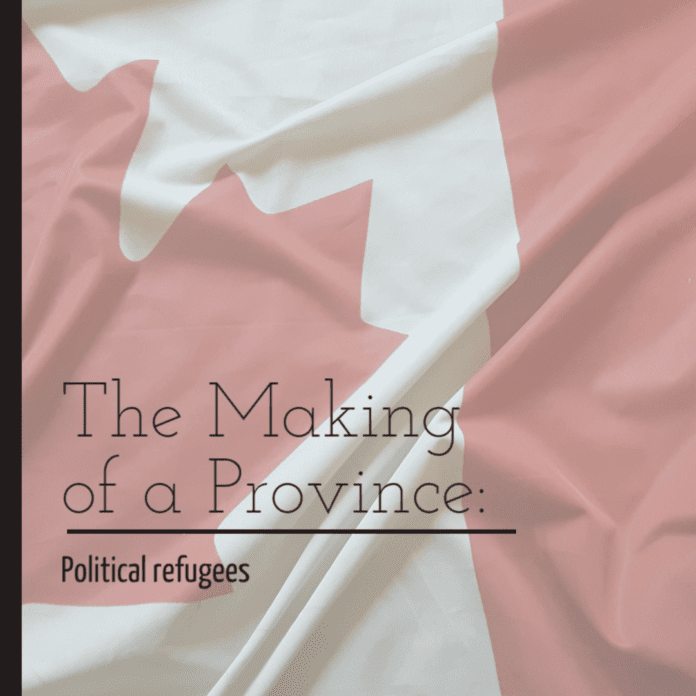These days, people often think of the United Empire Loyalists as a rather elitist organisation, a throwback to a more Imperial and aristocratic time. And this concept of the Loyalists is one which they have largely forged for themselves over time.
But the original Loyalists were far from being influential and aristocratic: they were, in fact, homeless political refugees, dependant on government for the basic necessities of life, having lost their property, professions, land, and wealth by choosing the wrong side in what was, essentially, a civil war.
When the Thirteen Colonies in British North America declared their independence from Great Britain, it is calculated that almost a quarter of the combined population of around two million sided with the British Crown.
The majority of these people kept their heads down and went through the Revolution to the end, without loss or trauma. But almost 60,000 either openly took sides against the rebels, or else were suspected of having loyalist sympathies, and more than a few of these were imprisoned, or forced to flee their homes and families.
In various districts, particularly Connecticut and New York, men formed militia companies to fight against the revolution, although many of these were relative newcomers of the Colonies, having been born in Britain and Ireland.
These militia men were separated from their wives and children, sometimes for years at a stretch, as they were gradually forced back into posts in Montreal, Sorel, Niagara and other places. As the tide of war turned against their cause, around 30,000 were evacuated from New York in 1783, as the peace treaty, which would end their hopes of ever returning to their previous lives, was being negotiated in Rome.
The enlisted men spent many weary months housed in barracks, facing an uncertain future, but depending on the British Crown to care for them. Their wives and children faced far harsher times, as they initially faced the fury and disdain of their republican neighbours, and then were forced to trek through wild and dangerous territory over many weeks to reach their husbands and fathers in their place of exile.
They were promised free grants of land to replace, if possible, all they had lost, as well as tools and supplies to rely on for three years after settling on new land.
The overwhelming majority of Loyalists chose to move to Nova Scotia, which was separated, as a result, into two provinces, with New Brunswick carved out of the older colony. Others stayed in the new province of Lower Canada, as it became after 1791, and only around 3,000 men, women and children chose to find new lives along the north shore of the St. Lawrence and the Bay of Quinté.
So it was that, in June, 1784, the St. Lawrence saw a sight that was new even to that great river, as thousands of refugees, men, women, and children, slowly worked their way upriver in boats to New Johnstown, now Cornwall, where they drew lots to see where they would find their new property. Sight unseen, whether it be swamp, or dense timber-covered wilderness, their only consolation was that they were settled together according to the militia companies in which they had served during the war.
One other slight advantage they had was that most of them had been farmers, well used to clearing and ploughing land. But this land was uncleared, with trees as tall as 120 feet, and wider than a man.
Although separated by some miles at times, neighbours came together to build log cabins as homes. These are described in one old account:
“The walls were formed of logs, roughly notched at the ends, and piled one above another to the height of seven or eight feet, while the spaces between the logs were chinked and carefully plastered within and without with clay mortar. Openings for a door and window were provided. Smooth, straight poles were laid lengthwise on the walls to serve as supports for the roof, which, at first, was thatched, but later was composed of strips of elm bark four or five feet in length by two or three feet in width. These were placed in rows over-lapping one another and fastened to the poles by withs.”
Doors and windows were usually comprised of blankets, and conditions remained rough for some years.
In 1788, known afterwards as “The Hungry Year”, severe shortage of crops led to malnutrition and death among the young and elderly. This was no comfortable and gentrified life for men and women who had once known something better.
The term “United Empire Loyalist” was granted to them by the Governor of the day, Lord Dorchester, a man who knew them and their history well, being the officer who had evacuated so many from New York. He, and his superiors, wished to bestow an honorific on these loyal people, all as part of a plan to raise up an aristocracy, a ruling class for the new province. Things did not turn out as planned.
But these political refugees became the foundation of the new province of Upper Canada, the ones who built Dundas and Grenville Counties, and whose children and grandchildren settled the lands in the new townships laid out to the north in later decades.
They helped make a new province.

